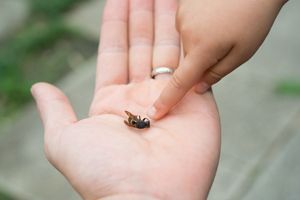Indoor Pesticides Linked to Childhood Blood Cancers
Children exposed to residential pesticides are at a higher risk of developing pediatric hematopoietic cancers, a new study has found.
Bee

Children exposed to residential pesticides are at a higher risk of developing pediatric hematopoietic cancers, a new study has found.
For this meta-analysis, published online in Pediatrics, investigators used the I2 statistic to measure the percentage of variation that cannot be explained by chance. They found that indoor insecticides were associated with a significant increase in risk of childhood leukemia (odds ratio [OR] = 1.47; 95% CI, 1.26—1.72; I2 = 30%) and childhood lymphomas (OR = 1.43; 95% CI, 1.15—1.78; I2 = 0%).
Exposure to herbicides was also associated with a significant increase in risk of leukemia (OR = 1.26; 95% CI, 1.10—1.44; I2 = 0%), but no association was found between outdoor residential insecticides and an increased risk of childhood leukemia or lymphoma.
There was also no statistically significant association between home pesticides and childhood brain tumors.
“We don’t know ‘how much’ exposure it takes, or if there’s a critical window in development,” Chensheng (Alex) Lu, senior author and associate professor of environmental exposure biology at the Harvard Chan School, told US News & World Report. “Is the window during pregnancy? Or even before pregnancy? That will take a much deeper investigation.”
The authors note that although current data do not establish a critical exposure period for the occurrence of childhood cancers, development is probably multifactorial and may include gene—environment interactions.
The National Institutes of Health (NIH) was recently awarded nearly $144 million in grants to develop tools and measures to investigate the impact of environmental exposures on pediatric health and development. The research will chronicle children from prenatal stages through later years of their childhood.
The three initiatives of the research projects are to develop tools to enhance studies of environmental influences of pediatric diseases, study the influence of environmental exposures on in utero development, and to expand the examination of environmental influences on later child development.
“Technology advances have become a powerful driver in studying and understanding the start and spread of disease,” NIH Director Francis S. Collins, MD, PhD, said in a statement. “These projects will expand the toolbox available to researchers to improve our ability to characterize environmental exposures, understand how environmental exposures affect in utero development and function, and bolster the infrastructure for exposure research.”
The authors of the meta-analysis acknowledge that the small number of studies examined is a major limitation of the analysis, and additional information is needed to confirm an association between indoor pesticide exposures and pediatric cancer.
Still, the researchers conclude that preventive measures should be taken to reduce childhood exposure to indoor pesticides.
“While the research community is working toward a better understanding of the causality of pesticides in various childhood diseases, more and more pesticides are being used in farming, in landscape maintenance, and in the home. Therefore, public health policies should be developed to minimize childhood exposure to pesticides in the home,” the authors note.
“In the meantime, parents, school and daycare teachers and healthcare providers can learn about common pesticide types and labeling information and can stay aware of the short- and long-term effects of these.”
Chen M, Chang CH, Tao L, et al. Residential exposure to pesticide during childhood and childhood cancers: a meta-analysis [published online September 14, 2015]. Pediatrics.
Shared Model of Care Post-HCT Offers Safe Follow-Up, Reduces Patient Burden
Published: March 19th 2025 | Updated: March 19th 2025Alternating post-HCT care between specialized facilities and local cancer centers produced noninferior non-relapse mortality and similar quality of life to usual care.


